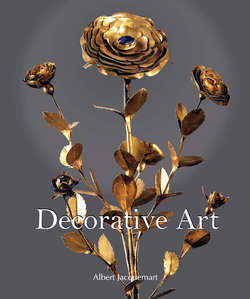Decorative Art

Реклама. ООО «ЛитРес», ИНН: 7719571260.
Оглавление
Albert Jacquemart. Decorative Art
Introduction
Furniture
Carved wooden furniture
Furniture inlaid with piqué
Ebony furniture inlaid with ivory or carved
Furniture inlaid with stones
Furniture styled with brass carving
Furniture overlaid with tortoise shell and metal
Furniture in marquetry of various woods
Furniture panelled with plaques of porcelain
Furniture lacquered in varnish or paint
Furniture in gilt or painted wood
Ornamental Art
Ornamental bronzes
Clocks and timepieces
Wrought iron, European arms, embossed brass, damascened metals
Arms
Repoussé coppers
Damascened metals
The goldsmith’s art
Jewellery
Tortoise shell, piqué, and posé d’or
Boxes and snuff boxes
Enamels
Cloisonné and champlevé enamels
Painted enamels
Venetian enamels
Glass
Objects of Art Derived from Statuary
Marble, stone, alabaster
Bronzes
Plaquettes and medallions
Ivories
Wood
Drapes and Fabrics
Tapestry
Arras
Lille
Brussels
The Gobelins
Beauvais
Embroidery and lace
Knitted fabric
Leather and wallpaper
Отрывок из книги
Diptych, 8th century. Elephant ivory, 34.3 × 10.7 cm. From the Beauvais Cathedral treasure. Musée de Cluny, Paris.
In discussing furniture, we must begin by defining the value of the word according to the various periods to which it is applied. In its literal and general meaning, furniture represents everything that is moveable, transportable, and easy to put away.
.....
To return to less exceptional things, let us go back to the Musée de Cluny, where the decorations from the Château de Villepreux, belonging to Pierre de Gondy, bishop of Paris, will show the luxury of the 16th century in a simpler form, and allow us to observe a bed more appropriat for contemporary use. We must also point out this important peculiarity, that the inventory of Catherine de Médici shows a very extensive collection of ebony cabinets inlaid with ivory which are of German fashion, that is, marquetry of various woods. However, it does not have pieces of wood-carved furniture which must have still been in use, as may be proved by those bearing the monogram of Henry II and the double crescent to be found in museums and among collections. It is an indication of the possible mingling of these three kinds of furniture making one whole set.
We still keep to the genuine 16th century so long as we do not see the rather cumbrous pieces of the time of Henry IV which lead directly to the style of Louis XIII. The furniture of this period of transition, which is occasionally sombre from the abuse of ebony, has already a degree of pomp announcing the century of Louis XIV. When we say furniture, we do not mean pieces of outward show, more luxurious than useful; this is one of the characteristics of the period of the great king. A more complete picture more clearly proving the absence of useful furniture could not be desired. In order to find such, in an intimate and charming form, we must pass to the reign of Louis XV, the king who deserted the state apartments to take refuge in places with secret doors and back staircases.
.....